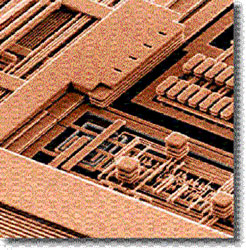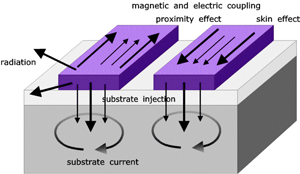|
|||||||
Mathematical Challenges in the Electronics Industryby Wil Schilders New generations of electronic devices and integrated circuits are characterised by shrinking dimensions and increasing frequencies. Electromagnetic effects that were previously neglected must now be taken into account in order to reliably predict behaviour. The Scientific Computing Group of the TU Eindhoven is developing new numerical techniques for coping with this challenging problem. The electronics industry has always been a very fertile working environment for mathematicians. In the 80s, the simulation of semiconductor devices provided an extremely challenging problem from the numerical point of view, and a similar observation can be made for the area of electronic circuit simulation in the 80s and 90s. Owing to the advent of new numerical methods, these simulations are now carried out routinely. A relatively new development within the electronics industry is the use of software for the simulation of interconnects structures connecting the different components in a large integrated circuit. Figure 1 shows such a structure. In present-day technologies, this structure may contain up to seven layers.
With shrinking dimensions and increasing frequencies, nearby metal tracks and layers can have an influence on each other. So far, these effects could be neglected when analysing the behaviour of an integrated circuit. However, there is clear evidence that this will not hold for future generations. Electromagnetic effects (see Figure 2) may influence the functioning of a circuit to the extent that signals are delayed intolerably. Clearly, this must be avoided, explaining the large interest in the topic of signal integrity. In close cooperation with Philips Research in Eindhoven, the Scientific Computing Group at the TU Eindhoven started an investigation into numerical techniques for the simulation of the problem. A European project (CODESTAR) was set up with two challenging tasks. Firstly, to develop efficient numerical techniques for solving the three-dimensional electromagnetic problem. Secondly, based on these calculations, to construct models with a small number of parameters that adequately describe the electromagnetic behaviour. This step is commonly referred to as 'reduced order modelling'. It has become clear that methods available for these tasks need a thorough revision in order to be able to cope with present demands of the electronics industry, and so the Scientific Computing Group concentrates on both aspects.
The time-dependent three-dimensional electromagnetic problem is commonly solved using the finite difference time domain method (FDTD), developed by Yee in 1966. The method is simple, and programming it is rather straightforward. However, there are some clear disadvantages. First of all, the time stepping is explicit, so the smallest spatial dimension dictates the time step. In addition, the spatial grid is often unnecessarily fine due to the finite difference character. The Scientific Computing Group has developed a general framework of time stepping methods, which relieve the strict stability conditions. This is extremely important for future simulations of signal integrity. Also, we are now working on other improvements, such as the use of parallel computing, combining two solutions on different staggered grids to improve the accuracy, and the introduction of local mesh refinement using local defect correction (LDC). The second main task is even more important than the first. In fact, reduced order modelling is a discipline, which receives growing attention in many application areas as well as in mathematics. To stress the importance, the Scientific Computing Group has organised several international workshops within the framework of the European network MACSI-net. Reduced order modelling aims at capturing complex behaviour into a compact model with a small number of parameters. The following sequence of figures clearly illustrates the intention: although only a few straight lines and planes describe the bunny on the right, it is clearly recognized as being a bunny. In the past year, we have developed a robust reduced order modelling technique based on an expansion in Laguerre functions, combined with Krylov subspace techniques. The method leads to low order models that are stable both in the frequency domain and the time domain, and has been implemented and tested in a Philips Research software tool for the simulation of electromagnetic compatibility. In the next year, it will be used within the framework of the CODESTAR project to generate compact representations of the electromagnetic behaviour of interconnects. Links: Please contact: |
|||||||





